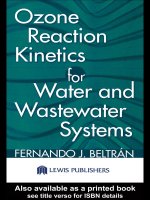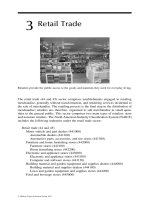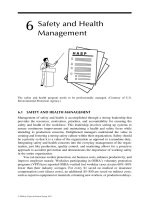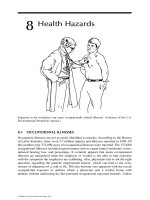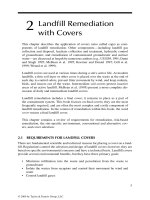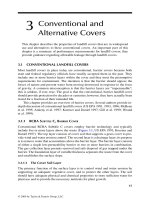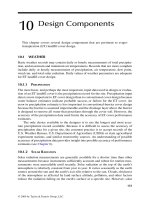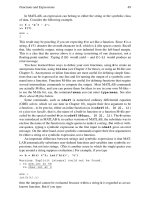Ozone Reaction Kinetics for Water and Wastewater Systems - Chapter 3 docx
Bạn đang xem bản rút gọn của tài liệu. Xem và tải ngay bản đầy đủ của tài liệu tại đây (420.06 KB, 16 trang )
©2004 CRC Press LLC
3
Kinetics of the Direct
Ozone Reactions
In this chapter the kinetics of ozone direct reactions is presented. It is evident that
the direct ozonation of molecular organic compounds points to a treatment that can
be used extensively in the direct ozonation of inorganic compounds.
Ozone reactions in water and wastewater are heterogeneous parallel-series gas
liquid reactions in which a gas component (ozone) transfers from the gas phase
(oxygen or air) to the water phase where it simultaneously reacts with other sub-
stances (pollutants) while diffusing. The main aim of the kinetic study is to determine
the rate constant of the reactions and mass transfer coefficients. This is achieved by
establishing the corresponding kinetic law.
1
As a difference from chemical equilib-
rium, kinetic laws are empirical and must be determined from experiments. According
to the type of experiments, the ozonation kinetic study can follow two different
approaches. The first one is based on experimental results of homogeneous ozonation
reactions. This is the case where ozone and any compound are previously dissolved
in water and then mixed to follow their concentrations with time. The kinetic law,
in this case, relates the chemical reaction rate with the concentration of reactants
(and products, in the case of reversible reactions). Thus, for any general irreversible
ozone direct reaction with a compound B,
(3.1)
z
O
3
,
z
B
,
and
z
P
being the stoichiometric coefficients of ozone,
B
and
P
respectively,
the kinetic law corresponding to the ozone or
B
chemical reaction rates are
(3.2)
and
(3.3)
where
k
,
n
, and m are the reaction rate constant and reaction orders with respect to
ozone and
B
, respectively. Notice that
z
A
and
z
B
have negative signs due to convention
rules. Both equations are related through the stoichiometric coefficients
(3.4)
zO zB zP
OB P33
+→
rzkCC
OOO
n
B
m
33
3
=
rzkCC
BBO
n
B
m
=
3
r
z
z
r
z
r
O
O
B
BB3
3
1
==
©2004 CRC Press LLC
In most of the studies, however, the ratio between coefficients,
z
B
/
z
O
3
=
z
, is consid-
ered, so that reaction (3.1) becomes as
(3.5)
where
z
has a minus sign when used in the rate law.
The second possibility is the study of ozonation kinetics as a heterogeneous
process — that is, as it develops in practice. In this second case, the absorption rate
of ozone or ozonation rate, N
O3
, represents the kinetic law of the heterogeneous
process. The stoichiometric equation is now
(3.6)
and reaction (3.1). Step (3.6) represents the mass transfer of ozone from the gas to
the water phase,
k
L
a
being the volumetric mass transfer coefficient (see Chapter 4).
The kinetic law equation is, in many cases, a complex expression (see Chapter 4)
that is deduced from transport phenomena studies, and it depends not only on the
concentrations, chemical rate constants, and reaction orders as in the homogeneous
case, but also on physical properties (diffusivities), equilibrium data (ozone solubil-
ity), and mass transfer coefficients.
2,3
Both the homogeneous and heterogeneous approaches present advantages and
drawbacks. For example, the homogeneous approach does not have the problem of
mass transfer, and rate constants can be obtained straightforwardly from experimental
data of concentration time. Unfortunately, this approach does not allow a comparison
between mass transfer and chemical reaction rates, and it is not suitable for very
fast ozone reactions unless expensive apparatus, such as the stopped flow spectro-
photometer, are available. The “heterogeneous approach” presents the problem of
mass transfer that must be considered simultaneously with the chemical reaction,
but any type of ozone reaction kinetics can be studied with simple experimental
apparatus. Also, this approach allows the mass transfer coefficients of the ozonation
system to be measured and, as a consequence, the relative importance of both
physical and chemical steps are established.
Regardless of the approach used, homogeneous or heterogeneous, the kinetic
study allows the determination of the rate constant, reaction orders (and mass
transfer coefficients, in this case). Kinetic law equations, r
O3
or N
O3
, come from
the application of mass balances of reacting species that depend on the type of
flow the phases (gas and water) have through the reactor (see Appendix A1). Mass
balance equations in a reactor are also called the reactor design equations. Also,
the type of reactor operation is fundamental. For example, the reactor can be a
tank where aqueous solutions of ozone and the target compounds are charged.
This is the homogeneous discontinuous or batch reactor case. The mass balance
is a differential equation that, at least depends on reaction time. In a different
situation, two nonmiscible phases, ozone gas and water containing ozone, and the
target compound, respectively, can be simultaneously fed to the reactor (tank,
column, etc.), and the unreacted ozone gas and treated water continuously leave the
OzB zP
3
+→
′
Og Ol
ka
L
33
() ()→
©2004 CRC Press LLC
reactor. This is the case of heterogeneous continuous reactors where operation is
usually carried out at stationary conditions. Then, reaction time is not a variable
and the mass balance is an algebraic or differential equation depending on the
flow type of the gas and water phases.
Reactors are also usually classified depending on the way reactants are fed and
on the type of flow of phases. Regarding the way reactants are fed, the reactors can be:
•Discontinuous or batch type
• Continuous type
Regarding the type of flow, applied only to the continuous reactor type, reactors are
ideal or nonideal. There are two situations for the ideal reactors:
• Perfectly mixed reactors
• Plug flow reactors
In the ideal reactors, the type of flow is based on assumptions that allow the equations
of mass balance of species to be established. There are also other phenomena, such
as the degree of mixing that influences the performance of reactors. In the cases that
will be treated here, perfect mixing or no mixing at all will only be considered for
ideal reactors. For a more detailed study of the influence of mixing degree the reader
should refer to other works.
4
In nonideal reactors, the flow of phases through the reactor does not follow the
hypothesis of ideality, and a nonideal flow study should first be undertaken. A
summary on ideal reactor design equations and details about nonideal flow studies
with ozone examples are presented in Appendix A1 and A3, respectively.
Having in mind the purpose of explaining the kinetics of ozonation reactions,
in this work, only the fundamentals of heterogeneous gas-liquid reactions are con-
sidered (see Chapter 4) because the homogeneous case is a more common situation
that can be followed in multiple chemical reaction engineering books.
1,5–7
3.1 HOMOGENEOUS OZONATION KINETICS
When a homogeneous reaction is studied, the rate law is exclusively a function of
the concentration of reactants, rate constant of the reaction, and reaction orders.
The kinetic study of homogeneous ozone reactions could preferentially be car-
ried out in three different ideal reactors (see Appendix A1):
• The perfectly mixed batch reactor
• The continuous, perfectly mixed reactor
• The continuous plug-flow reactor
3.1.1 B
ATCH
R
EACTOR
K
INETICS
In practice, the reactions are usually carried out in small flasks that behave as perfectly
mixed batch reactors. In these reactors, the concentration of any species and temperature
©2004 CRC Press LLC
are constant throughout the reaction volume. This hypothesis allows the material balance
of any species,
i
, present in water to be defined as follows:
(3.7)
where
Ni
and
V
are the molar amount of compound
i
charged and the reaction
volume, respectively and
r
i
the reaction rate of the
i
compound. Since ozone reactions
are in the liquid phase, there is no volume variation and, hence, equation (3.7) can
be expressed as a function of concentration, once divided by
V
:
(3.8)
Another simplification of the ozonation kinetics is due to the isothermal character
of these reactions so that the use of the energy balance equation is not needed.
In a general case, ozonation experiments aimed at studying the kinetic of direct
ozone reactions are developed in the presence of scavengers of hydroxyl radicals
and/or at acid pH so that the ozone decomposition reaction to yield hydroxyl radicals
is inhibited (see Chapter 2). This is so because the chemical reaction rate,
r
i
, presents
two contributions due to the direct reaction itself and the hydroxyl radical reaction.
Thus, for an ozone reacting compound B, the chemical reaction rate is
(3.9)
where
k
HOB
and
C
HO
are the rate constant of the reaction between
B
and the hydroxyl
radical and its concentration, respectively. Addition to the reacting medium of
hydroxyl radical scavengers and/or carrying out the reaction at acid pH yields
negligible or no contribution of the free radical reaction [second term of the right
side in equation (3.9)] to the
B
chemical reaction rate. In this way, the kinetics of
B
would be exclusively due to the direct reaction with ozone. It should be highlighted,
however, that appropriate treatment of the concentration-time data of the scavenger
substance, usually of known hydroxyl and ozone reaction kinetics, allows the con-
centration of hydroxyl radical be known (see the R
CT
concept in Chapter 7). Also,
the scavenger substance should not react directly with ozone. For example, p-chlo-
robenzoic acid (pCBA),
8
atrazine
9
or benzene
10
are appropriate candidates. The rate
constants of their direct reactions with ozone are very low (<10 M
–1
s
–1
) and those
corresponding to their reaction with hydroxyl radical are well established. In these
cases, the concentration of hydroxyl radical can be determined from the chemical
reaction rate of the scavenger,
r
S
, that in a batch reactor is
(3.10)
dN
dt
rV
i
i
=
dC
dt
r
i
i
=
−= +rzkCCkCC
BDOBHOB HO B3
r
dC
dt
kCC kC
S
S
HOS HO S HOS S
=− = =
′
©2004 CRC Press LLC
where
k
HOS
and
C
S
are the rate constant of the reaction between the hydroxyl radical
and the scavenger substance and its concentration, respectively. Then, the concen-
tration of hydroxyl radicals can be determined from the slope of the straight line
resulting of a plot of the logarithm of
C
S
against time. Thus, once
C
HO
is determined,
known the value of
k
HOB
(see Chapters 7 to 9), the direct rate constant
k
D
can also
be determined after applying equations (3.8) and (3.9). Notice that the concentration
of hydroxyl radical can also be calculated from the R
CT
concept
8
which also needs
a reference or scavenger compound and the measured data of ozone concentration
time (see also Chapter 7).
The ozone reaction is carried out with one of the reactants (ozone or B) in excess
so that the process behaves as a pseudo-nth order reaction. For example, if it is
assumed that compound B is in excess, then its concentration keeps constant with
time while that of ozone diminishes. Application of the material balance of ozone
in a batch reactor [
i
=
O
3
, equation (3.8)] once the contribution of the hydroxyl free
radical reaction has been neglected leads to
(3.11)
where
k
′
D
is the pseudo-nth order rate constant referred to ozone and the minus sign
is due to the negative value of the stoichiometric coefficient of ozone [–1 in equation
(3.5)]:
(3.12)
with
k
D
and
m
being the actual rate constant of reaction (3.5) and reaction order in
regard to
B
, respectively.
Integration of equation (3.11) leads to
•For
n
= 1:
(3.13)
and
•For
n
≠
1
(3.14)
where
C
O
3
o
is the concentration of ozone at
t
= 0. In most of the reactions of ozone, equation
(3.13) has been confirmed from experimental data so that reactions are first order with respect
to ozone. If this procedure is applied to experiments where the concentration of B has
dC
dt
kC
O
DO
n
3
3
=−
′
′
=kkC
DDB
m
Ln
C
C
kt
O
Oo
D
3
3
=−
′
C
n
C
n
kt
O
n
Oo
n
D
3
1
3
1
11
−−
−
=
−
−
′
©2004 CRC Press LLC
been changed, different values of
k
′
D
are obtained. Equation (3.12) expressed in logarithmic
form becomes
(3.15)
According to equation (3.15), a plot of the left side against the logarithm of the
concentration of
B
should lead to a straight line of slope equal to the reaction order
with respect to
B
. The true rate constant, referred to ozone, of reaction (3.5) is
obtained from the intercept of this line. In most of the ozone reactions, the value of
m
is also 1, so that the direct ozonation can be catalogued as a second order
irreversible reaction. Notice that this procedure can also be applied to experiments
where the ozone concentration is in excess and the concentration does not change
with time during the reaction period. In these cases,
k
B
=
zk
D
, the rate constant
referred to B is directly determined. Examples of these procedures can be followed
from the works of Hoigné and coworkers
11–14
that have determined and compiled
multiple data on rate constants for inorganic and organic compound-ozone direct
reactions. In addition to these works, Table 3.1 presents a list of other research works
on homogeneous ozonation kinetics where these procedures were carried out.
The procedure shown above allows the direct determination of the absolute rate
constant of the ozone-compound reaction and it can be named as the absolute
method. Another possible approach to follow involves ozone experiments where the
aqueous solution initially contains the target compound, B, and another one or
reference compound, R, of known ozone kinetics, that is, known rate constant and
stoichiometry. This is named the competitive kinetics method. Now, both mass
balance equations of B and R applied to the batch reacting system [(3.8)-type
equations] are divided by each other to yield the following equation:
(3.16)
where z
rel
is the ratio of stoichiometric coefficients of the ozone-B and ozone-R
reactions and k
rel
the ratio of their corresponding reaction rate constants. After
variable separation and integration, equation (3.16) leads to
(3.17)
which indicates that a plot of the logarithm of the left side against the logarithm of
the ratio between the concentration of R at any time and at the start of ozonation leads
to a straight line of slope z
rel
k
rel
. Now, z
rel
being known and the rate constant of the
ozone-R reaction, the target rate constant is obtained from the slope of the plotted
straight line. This method has also been applied to different works (see Table 3.1). The
method presents the advantage that there is no need for the ozone concentration be
known. However, the reference compound should have a reactivity towards ozone
Lnk Lnk mLnC
DD B
′
=+
dC
dC
zk
C
C
B
R
rel rel
B
R
=
ln ln
C
C
zk
C
C
B
B
rel rel
R
R00
=
©2004 CRC Press LLC
TABLE 3.1
Works on Homogeneous Ozonation Kinetics
Compound Observations
Reference #
and Year
Phenol SF, AKC, 5 to 35ºC, pH = 1.5–5.2, n = m = 1, 1/z = 2,
k = 895 (25ºC, pH 1.5), k = 29520 (25ºC, pH 5.2),
AE = 5.74 kcalmol
–1
15 (1979)
Dyes, CN
–
and CNO
–
SF, 25ºC, for dyes: AKO3, n = m = 1, pH 4–7, k = 2.8 ×
10
4
(Naphthol yelow), k = 1.8 × 10
6
(Methylene blue),
For CN
–
, AKC, n = 0.8, m = 0.55 at 9.4 < pH < 11.6,
k = 310
16 (1981)
Bromide Reactor: 10 cm quartz cell, pH: 1.2–3.6, 5–30ºC, k =
4.9 × 10
9
exp(–10
4
/RT) + 1.7 × 10
12
exp(–1100/RT)C
H+
17 (1981)
Nondissociating organics Determination of rate constants of different
nondissociating organic compound-ozone reactions.
pH=1.7–7, 20ºC, presence of hydroxyl radical
scavengers. Different methods applied (Ozone or B in
excess, absolute and competitive methods to
determine rate constants). 1/z between 1 and 2.5. For
k values see Reference 8
11 (1983)
Dissociating organics Determination of rate constants of different dissociating
organic compound-ozone reactions. 20ºC, pH varying
depending on compound. Different methods applied
(Ozone or B in excess, absolute and competitive
methods to determine rate constants). For k values see
Reference 9
12 (1983)
Phenanthrene SF, AKO3, pH=2–7, 10–35ºC, n = m = 1, k = 19400
(pH=2.2), k = 47500 (pH 7) at 25ºC, AE between
7 (pH=3) and 12 kcalmol
–1
at other pH values
18 (1984)
Benzene SF, AKC, pH:3 and 7, 5–35ºC, 1/z = 1, Reaction orders
vary with pH. Rate constant at pH 7 likely implies
radical reactions, k = 0.012 (pH=3), k = 12.2 s
–1
(pH=7),
AE between 20.9 (pH=3) and 3.3 kcalmol
–1
(pH=7).
19 (1984)
Cyanide SF, AKC, pH=2.5–12, 20ºC, n = 1, m = 0.63, k = 550 ±
200 (pH=7) and other
20 (1985)
Inorganic compounds Different methods (absolute and competitive, stopped
flow, etc.). Rate constants at different pH, 20ºC, n =
m = 1; for k values see Reference 10
13 (1985)
Naphthalene 1-L Batch reactor, AKC, pH=5.6, 1ºC, n = m = 1, k =
550 M
–1
s
–1
, 1/z = 2
21 (1986)
Haloalkanes, olefins,
pesticides and other
Determination of rate constants of different organic
compound-ozone reactions. 20ºC, pH varying
depending on compound. Different methods applied
(Ozone or B in excess, absolute and competitive
methods to determine rate constants). 1/z between
1 and 4, For k values see Reference 11
14 (1991)
©2004 CRC Press LLC
TABLE 3.1 (continued)
Works on Homogeneous Ozonation Kinetics
Compound Observations
Reference #
and Year
Herbicides AKC, CK also applied. pH:2 and 7 in the presence of
carbonates. 20ºC, at pH 2: k(MCPA) = 11.7, k(2,4D) =
5.27; at pH 7: k(MCPA) = 41.9, k(2,4D) = 29.14. For
other k values see Reference 19
22 (1992)
Naphthol, Naphthoate CK, Naphthalene: reference compound. 1-propanol as
scavenger, pH:2.1–3.6, 20ºC: k
NOH
= 8600 and k
NO–
=
5 × 10
9
23 (1995)
Ammonia SF, AKC, pH=8–10, 25ºC, n = m = 1. The O
3
/H
2
O
2
oxidation also investigated, k = 12.3 (pH 8), k = 27.0
(pH=10)
24 (1997)
Benzene SF, AKC, pH=5.2–5.4, 25ºC, 1/z = 1, m = n = 0.5, k =
2.67 s
–1
25 (1997)
Pentachlorophenol SF, AKO3, pH=2 to 7, 10–40ºC. n = m = 1, k = 7.55 ×
10
4
(pH 2) and k = 2.49 × 10
7
(pH 7), AE: 27 kJmol
–1
26 (1998)
Ethene (A), Methyl (B) and
Chlorine (C) substituted
derivative
SF, AKC, n = m = 1, 25ºC, k
A
= 1.8 × 10
5
, k = 14 (TCE),
k = 8 × 10
5
(propene) and other (see Reference 24)
27 (1998)
Nitrobenzene and 2,6-DNT Batch reactors, AKC, pH 2, t-butanol as scavenger,
2–20ºC, k(NB) = 259exp(–1403/T), k(DNT) = 1.2 ×
10
6
exp(–3604/T)
28 (1998)
Alicyclic amines 2.5-L Batch reactor. AKO3, pH 7 phosphate buffer, n =
m = 1 (assumed), k = 6.7 (pyrrolidine), k = 9.8
(piperidine), k = 29000 (morpholine), k = 4000
(piperazine) and other (see Reference 25)
29 (1999)
Aminodinitrotoluene Batch reactor, CK, resorcinol: reference compound,
pH 5, 20ºC, k
a-ADNT
= 1.45 × 10
5
, k
4-ADNT
= 1.8 × 10
5
30 (2000)
Atrazine and ozone-
byproducts
Batch reactor, AKC, pH:2, 20ºC, k
AT Z
= 6, k
CDIT
= 0.14,
k
DEA
= 0.18, k
DIA
= 3.1 and other (see Reference 27)
31 (2000)
Cyclopentanone (CP) and
methyl-butyl-ketone (MBK)
Batch reactor, AKC, 0.05-0.5 M HClO
4
,
k(CP) = 7.95 × 1011exp(–18000/RT), k(MBK) = 5.01 ×
1010exp(–16200/RT) AE in calmol
–1
32 (2000)
3-methyl-piperidine Batch reactor, AKC, pH:4–6, t-butanol as scavenger,
k = 6.63
33 (2001)
Microcystin-LR SF, AKO3, pH 2–7, k = 3.4 × 10
4
(pH 7), k = 10
5
(pH 2),
AE = 12 kcalmol
–1
34 (2001)
MTBE and ozone-byproducts Batch rector, AKC, pH 2, 5–20ºC, k
MTBE
= 0.14, k =
0.78 (t-butylformate) and other
35 (2001)
Metal-diethylenetrimine-
pentaacetate (DTPA)
SF, AKC, 25ºC, pH:7.66, k
CaDTPA(2–)
= 6200, k
ZnDTPA(3–)
=
3500,
k
Fe(III)OHDTPA(3–)
= 240000 and other (see Reference 31)
36 (2001)
Blue dye 81 SF, AKC, 1/z = 1, 22ºC, Only pseudo first order rate
constant are given.
37 (2001)
©2004 CRC Press LLC
similar to that of the target compound, B, and the accuracy of the rate constant
determined will depend on that of the rate constant of the ozone-R reaction.
3.1.2 FLOW REACTOR KINETICS
Kinetic studies of homogeneous ozone direct reactions can also be carried out in
flow reactors such as the ideal plug flow and continuous stirred tank reactors (see
Appendix A1). In these cases, in addition to the reactor itself, other experimental
parts are needed that make the procedure more complex. Parts needed include tank
reservoirs to contain the aqueous solutions of ozone and the target and scavenger
compounds B and S, and pumps to continuously feed both solutions to the reactor
and measurement devices for the flow rates.
These reactors present another drawback with respect to batch reactors. This is
related to the concentration-time data obtained. Thus, in batch reactors, from only
one experimental run, the concentration-time data obtained is sufficient to determine
the apparent rate constant and B, or ozone reaction order, depending on the reactant
in excess. As flow reactors usually operate at steady state, only one value of the
concentration (at the reactor outlet) is obtained in each experimental run. Thus,
determination of the apparent rate constant is less accurate. On the other hand, the
procedure for the determination of the direct rate constant in flow reactor experiments
TABLE 3.1 (continued)
Works on Homogeneous Ozonation Kinetics
Compound Observations
Reference #
and Year
Six dichlorophenols SF, AKC, pH 2–6, 5–35ºC, 1/z = 2, n = m = 1, k
2,4DCP
=
10
7
(pH = 6) and other, AE ranging from 44.5 to
55,3 kJmol
–1
38 (2002)
Naphthalenes and
nitrobenzene sulphonic acids
Batch reactor, AKO3, pH 3–9, Atrazine to determine
hydroxyl radical concentration. k
D
at 20ºC:
1,5-naphthalene-disulphonic acid: 41. 1-naphthalene-
sulphonic acid: 252. 3-nitrobenzene-sulphonic acid:
22
39 (2002)
Methyl-t-butyl-ether 2-L Batch reactor for determination of reaction orders:
n = m = 1. 1-L continuous perfectly mixed reactor for
rate constant data determination: pCBA as scavenger
to determine hydroxyl radical concentration.
k
D
= 1.4 × 10
18
exp(–95.4/RT), AE in kJmol
–1
.
10 (2002)
Notes: SF: Stopped flow spectrophotometer used. AKC: Absolute method to determine k with compound
in excess (see Section 3.1). AKO3: Absolute method to determine k with ozone in excess. CK: Competitive
kinetics to determine k. AE: Activation energy. n: ozone reaction order. m: compound reaction order. Units
of k in M
–1
s
–1
unless indicated. Other stoichiometric ratio values of ozone direct reactions, determined
from homogeneous aqueous solutions, are given in Table 5.6.
©2004 CRC Press LLC
is similar to that shown above for the batch reactor. It starts with the application of
the corresponding reactor design equation (see Appendix A1) which is the mass
balance of ozone or B; application of experimental data to this equation allows the
determination of the rate constant and reaction orders. Furthermore, in a plug flow
reactor, the procedure is the same as in a batch reactor since the mathematical
expression of the design equation of both reactors coincide. The only difference is
that t (the actual reaction time in a batch reactor) is the hydraulic residence time, τ
the reactor volume to volumetric flow rate ratio (see Appendix A1), and that appli-
cation of the integrated equations (3.13) or (3.14) or (3.17) require data at steady
state from experiments at different hydraulic residence time. In a continuous perfectly
mixed reactor, the mathematical procedure is easier because the design equation is
now an algebraic expression. For example, in a case where reaction is carried out
in the presence of a hydroxyl radical scavenger with ozone concentration in excess,
the design equation or mass balance of B, once the steady state has been reached,
is (see also Appendix A1):
(3.18)
where v
0
and v represent the volumetric flow rates of the aqueous solution containing
B at the reactor inlet and outlet, respectively, and C
B0
and C
B
their corresponding
concentrations, respectively. Equation (3.18) has two unknowns, k″
D
and m so that
more than one experiment should be needed to determine these parameters. This
drawback, however, can be eliminated since ozone direct reactions are usually of
first order with respect to ozone and B (see works quoted in Table 3.1) so that (with
m = 1) from just one single experiment, k″
D
can be determined. Although unusual in
literature, this procedure has been applied by Mitani et al.
10
to determine the rate
constant of the direct reaction between ozone and methyl-t-butyl-ether (MTBE),
although the authors also considered in equation (3.18) the reaction rate term due
to the hydroxyl radical-MTBE. As a consequence, the experiment was carried out
in the presence of pCBA to know the value of the concentration of hydroxyl radicals
through the R
CT
parameter
8
(see also Chapter 7). They also measured the concen-
tration of ozone at the reactor outlet so that they determined directly from the design
equation the actual direct rate constant as follows:
(3.19)
The value of k
HOB
had been previously determined from the competitive oxidation
of MTBE and benzene.
10
Data on reaction rate constant for the ozone-MTBE system
is also given in Table 3.1.
3.1.3 INFLUENCE OF PH ON DIRECT OZONE RATE CONSTANTS
Data on rate constant values so far determined (see Table 3.1) show that the reactivity
of ozone with some inorganic and organic dissociating compounds extraordinarily
vC vC zk C C k C V
Bo B D O
n
B
m
DB
m
03
−= =
′′
k
vC vC k C CV
zC C V
D
BBHOB HO B
OB
=
−−
00
3
©2004 CRC Press LLC
changes with pH, which constitutes a fundamental aspect on the ozone kinetics.
Notice that indirect reactions of ozone are also pH dependent so that in an ozonation
process the increase of ozonation rate with pH can be due not only to the indirect
reactions but also to the direct reactions. This could lead to some errors when
interpreting the ozonation kinetics since also at high pH the direct ozone reaction
can be the one responsible for the removal of pollutants (i.e., phenols; see Chapter 7).
Because of the importance in water pollution, the reaction between ozone and a
phenol compound has been taken here as a typical example. Phenol compounds
dissociate according to the equilibrium:
(3.20)
Thus, depending on the pH and pK values, the degree of dissociation is
(3.21)
This means that the ratio between concentrations of the dissociating and nondisso-
ciating forms of the phenol compounds varies with pH and with the reactivity with
ozone. At low pH value the phenol compound is only present in its nondissociating
form (α = 0) while at a pH higher than the pK, only the dissociating form is in
water (α = 1). As was shown in Chapter 2 for the activation of electrophilic aromatic
substitution reactions, the activating character of substituting groups strongly influ-
ence the reaction rate. Thus, the –O− group is a stronger activating group than the
–OH group and, then, the reactivity of phenols towards ozone increases with pH,
as it is observed experimentally. In fact, when the reaction is carried out at an
intermediate pH — around the pK value — the rate constant of the ozone-phenol
reaction follows equation (3.22):
(3.22)
where k
Ndis
and k
dis
are the rate constants of the reactions of ozone with the nondis-
sociating and dissociating forms of the phenol compound, respectively. Equation
(3.22) takes into account the contribution of both direct reactions of ozone. In a
general case, the variation of k
D
with pH follows a sigmoidal curve as shown in
Figure 3.1 for a general ozone–phenol compound reaction case. Figures similar to
Figure 3.1 have been reported in literature.
12,40
As deduced from literature data,
12
rate constants of phenol compound–ozone
reactions at alkaline pH are very high. This means that the kinetics of ozonation is
accomplished in a few seconds or even less. Therefore, determination of the con-
centration at different times has to be followed with special apparatus such as the
stopped-flow spectrophotometer. Examples of this approach are quoted in Table 3.1.
In this kind of study, the reaction is carried out in a spectrophotometer cell where
the reaction can be stopped at different microseconds of time, thus allowing the
determination of the concentration time profile (see references in Table 3.1). Notice
that in some cases scavenger (t-butanol, carbonates) hydroxyl radicals were added
α=
+
−
1
110
pH pK
kk k
D
Ndis dis
=−+()1 αα
©2004 CRC Press LLC
to the aqueous solutions of ozone and compound B to eliminate any possible
competition of the ozone decomposition and hydroxyl radical reactions in water.
This is particularly important when the ozone-B reaction presents a low reactivity,
as will be discussed in Chapter 5.
3.1.4 DETERMINATION OF THE STOICHIOMETRY
As can be deduced from reaction (3.5) the stoichiometric ratio, z, represents the
number of moles of compound B consumed per mole of ozone consumed. This
parameter should be calculated to know the difference between the disappearance
rates of ozone, r
O3
and compound B, r
B
. In addition, the stoichiometric ratio is a
fundamental parameter to establish the kinetic regime of the ozone absorption when
ozone undergo fast reactions in water and, hence, to define the kinetics of the
heterogeneous reaction of ozone with the compound B as will be shown in Chapter 5.
In practice, the inverse of z is usually determined because z is in most cases a
number lower than unity. The stoichiometric ratio is, as a rule, determined from the
mixture of aqueous solutions of different known concentrations of ozone and the
target compound B. After mixing, the ratio of the initial concentrations of the
resulting solution, C
Bo
/C
O3o
, becomes C
B
/C
O3
. Then, the apparent stoichiometric ratio
is
(3.23)
In all cases, when z
ap
is plotted against C
Bo
/C
O3o,
a curve like that shown in Figure 3.2
is obtained. As can be deduced from Figure 3.2, the true stoichiometric ratio of the
ozone-B reaction, 1/z, should be the asymptotic value of the curve corresponding to
high values of the ratio between initial concentrations of B and ozone. At low values
FIGURE 3.1 Influence of pH on the rate constant of the direct reaction of ozone with a
phenol compound. (x and y axis present arbitrary values).
pK
k
× 10
–3
,m
3
/mol
–1
s
–1
0 2 4 6 8 10 12 14
pH
60
50
40
30
20
10
0
–10
z
CC
CC
ap
Oo O
Bo B
=
−
−
33
©2004 CRC Press LLC
of this ratio, ozone is consumed not only by compound B but also in different
reactions with intermediate compounds that results in high values of z
ap
. When the
ratio C
Bo
/C
O3o
increases, reactions of intermediates diminish and, as a consequence,
z
ap
. When C
Bo
is in excess, ozone is consumed exclusively by reacting with B so
that z
ap
keeps constant regardless of the C
Bo
/C
O3o
value. For this situation, z
ap
repre-
sents the inverse of the true stoichiometric ratio, 1/z. Literature also reports numerous
stoichiometric ratio values determined in this way for different ozone reactions (see
also, Tables 3.1 and 5.6 for examples).
3.2 HETEROGENEOUS KINETICS
When ozone reactions are carried out in practice, that is, by feeding an air or oxygen
gas containing ozone into the aqueous solution of the target compound B, the process
is heterogeneous and kinetic equations usually express the amount of ozone absorbed
per unit time and volume. These equations, as a difference from those of the
homogeneous process, not only involve chemical reaction parameters (i.e., the chemical
reaction rate constant) but also transport coefficients (i.e., mass transfer coefficient).
Thus, the heterogeneous study allows the relative importance of chemical and phys-
ical steps that simultaneously develop to be established. In this sense, ozonation
kinetics can be classified as fast, moderate, or slow reactions, and any one of these
situations leads to different rate laws. Because of this diversity, it is advisable to
introduce the following chapter on the fundamentals of gas–liquid reactions before
going ahead with the heterogeneous ozonation kinetics that is developed in Chapter 5.
FIGURE 3.2 Variation of the apparent stoichiometric ratio of a general direct reaction
between ozone and a given compound using the homogeneous method. Determination of the
stoichiometric ratio, 1/z (x and y axis present arbitrary values).
C
Bo
/C
O3o
0 1 2 3 4 5 6 7
Actual stoichiometric ratio, 1/z
1/
z
, Ozone mol consumed / B mol consumed
0
2
4
6
8
10
12
14
©2004 CRC Press LLC
3.2.1 DETERMINATION OF THE STOICHIOMETRY
The stoichiometric coefficient of any general ozone direct reaction (3.5) can also be
determined from heterogeneous ozonation experiments where an ozone containing
gas mixture is continuously fed to an aqueous solution where the target compound
B is dissolved at known concentration. As in the homogeneous case, the main
difficulty is due to the competition of secondary reactions for the available ozone.
In the heterogeneous case, molar amounts of reacted ozone and B are calculated at
different reaction periods and plotted with each other in logarithmic coordinates as
shown in Figure 3.3. The ratio of these amounts, that is, the ordinate of the resulting
curve or straight line, represents the global stoichiometry of reaction (3.5), 1/z
G
,
which is defined as the moles of ozone consumed in all reactions it undergoes in
water per mol of B consumed. When the slope of the plotted line is unity, secondary
reactions consuming ozone are negligible and z
G
is, in fact, z
app
. At higher reaction
periods, the slope likely deviates from unity; that is, 1/z
G
increases as a consequence
of the importance of secondary ozone reactions (see Figure 3.3). The procedure was
used by Sotelo et al.
41
to determine the true stoichiometric ratio of the ozone–resor-
cinol and ozone–pholoroglucinol direct reactions (see also Section 5.3.1).
REFERENCES
1. Levenspiel, O. Chemical Reaction Engineering, 3rd ed. John Wiley & Sons, New
York, 1999.
2. Danckwerts, P.S.V. Gas–Liquid Reactions, McGraw-Hill, New York, 1970.
3. Chaudhari, R.V. and Ramachandran, P.A., Three-phase slurry reactors, AIChE J., 26,
177–201, 1980.
FIGURE 3.3 Variation of molar amounts of ozone and B consumed in a heterogeneous
ozonation experiment at different reaction times. Determination of the stoichiometric ratio,
1/z. (x and y axis present arbitrary values).
∆M
B
× 10
5
, mol B consumed
1 10 100
∆M
O
3
× 10
5
, ozone mole consumed
Actual stoichiometric ratio, 1/z
Slope = 1
1
10
100
©2004 CRC Press LLC
4. Trambouze, P., Van Landeghem, H. and Wauquier, J.P., Les Reacteurs Chimiques.
Conception/Calcul/Mise en Oeuvre, Editions Technip, Paris, 1984.
5. Moore, J.W. and Pearson, R.G. Kinetics and Mechanism. A Study of Homogeneous
Chemical Reactions, 3rd ed., John Wiley & Sons, New York, 1981.
6. Smith, J.M. Chemical Engineering Kinetics. Chemical Engineering Series, 2nd ed,,
McGraw-Hill, New York, 1970.
7. Butt, J.B., Reactor Kinetics and Reactor Design, Prentice-Hall, Englewood Cliffs,
New Jersey, 1980.
8. Elovitz, M.S. and von Gunten, U., Hydroxyl radical/ozone ratios during ozonation
processes. I. The R
CT
concept, Ozone Sci. Eng., 21, 239–260, 1999.
9. von Gunten, U., Hoigné, J. and Bruchet, A., Oxidation in ozonation processes.
Application of reaction kinetics in water treatments. In Proceedings of the 12th Ozone
World Congress, Vol 1, pp. 17–25, Lille, France, 1995.
10. Mitani, M.M. et al., Kinetics and products of reactions of MTBE with ozone and
ozone/hydrogen peroxide in water. J. Haz. Mater., B89, 197–212, 2002.
11. Hoigné, J. and Bader, H. Rate constants of the reactions of ozone with organic and
inorganic compounds. I. Nondissociating organic compounds. Water Res., 17, 173–183,
1983.
12. Hoigné, J. and Bader, H. Rate constants of the reactions of ozone with organic and
inorganic compounds. II. Dissociating organic compounds. Water Res., 17, 185–194,
1983.
13. Hoigné, J, et al., Rate constants of the reactions of ozone with organic and inorganic
compounds. III. Inorganic compounds and radicals. Water Res., 19, 993–1004, 1983.
14. Yao, C.C.D. and Haag, W.R., Rate constants of direct reactions of ozone with several
drinking water contaminants. Water Res. 25, 761–773, 1991.
15. Li, K.Y., Kuo, C.H., and Weeks, J.L., A kinetic study of ozone-phenol reaction in
aqueous solutions, AIChE J., 25, 583–591, 1979.
16. Teramoto, M. et al., Kinetics of the self-decomposition of ozone and the ozonation of
cyanide ion and dyes in aqueous solutions, J. Chem. Eng. Japan, 14, 383–388, 1981.
17. Haruta, K. and Takayama, T., Kinetics of oxidation of aqueous bromide ion by ozone,
J. Phys. Chem., 85, 2383–2388, 1981.
18. Cornell, L.P. and Kuo, C.H., A kinetic study of ozonation of phenanthrene in aqueous
solutions, Trans. Air Pollut. Control Assoc., 2, 275–286, 1984.
19. Kuo, C.H. and Soong, H.S., Oxidation of benzene by ozone in aqueous solutions,
The Chem. Eng. J., 28, 163–171, 1984.
20. Gurol, M.D., Bremen, W.M., and Holden, T.E., Oxidation of cyanides in industrial
wastewater by ozone, Env. Progr., 4, 46–51, 1985.
21. Legube, B. et al., Ozonation of naphthalene in aqueous solution-II kinetic studies of
the initial reaction step, Water Res., 20, 209–214, 1986.
22. Xiong, F. and Graham, N.J.D., Rate constants for herbicide degradation by ozone,
Ozone Sci. Eng., 14, 283–301, 1992.
23. Chan, W.F. and Larson, R.A., Ozonolysis of aromatic compounds in aqueous solutions
containing nitrite ion, Ozone Sci. Eng., 17, 627–635, 1995.
24. Kuo, C., Yuan, F. and Hill, D.O., Kinetics of oxidation of ammonia in solutions
containing ozone with or without hydrogen peroxide, Ind. Eng. Chem. Res., 36,
4108–4113, 1997.
25. Kuo, C.H. et al., Vapor and liquid phase ozonation of benzene, Ozone Sci. Eng., 19,
109–127, 1997.
26. Kuo, C.H. and Huang, C.H., Kinetics of ozonation of pentachlorophenol in aqueous
solutions, Ozone Sci. Eng., 20, 163–173, 1998.
©2004 CRC Press LLC
27. Dowideit, P. and von Sonntag, C., Reaction of ozone with ethene and its methyl- and
chlorine-susbtituted derivatives in aqueous solution, Env. Sci. Technol., 32, 1112–1119,
1998.
28. Beltrán, F.J., Encinar, J.M., and Alonso, M.A., Nitroaromatic hydrocarbon ozonation
in water. 1. Single ozonation, Ind. Eng. Chem. Res., 37, 25–31, 1998.
29. Pietsch, J. et al., Kinetic and mechanistic studies of the ozonation of alicyclic amines,
Ozone Sci. Eng., 21, 23–37, 1999.
30. Spanggord, R.J., Yao, D., and Mill, T., Kinetics of aminodinitrotoluene oxidations
with ozone and hydroxyl radical, Env. Sci. Technol., 34, 450–454, 2000.
31. Acero, J.L., Stemmler, K., and von Gunten, U., Degradation kinetics of atrazine and
its degradation products with ozone and OH radicals: A predictive tool for drinking
water treatment, Env. Sci. Technol., 34, 591–597, 2000.
32. Zimin, Y.S. et al., Kinetics of ketone oxidation by ozone in water solutions. Kinetics.
and Catal., 41, 745–748, 2000.
33. Carini, D. et al., Ozonation as pre-treatment step for the biological batch degradation
of industrial wastewater containing 3-methyl-piperidine, Ozone Sci. Eng., 23, 189–198,
2001.
34. Shawwa, A.R. and Smith, D.W., Kinetics of microcystin-LR oxidation by ozone,
Ozone Sci. Eng., 23, 161–170, 2001.
35. Acero, J.L. et al., MTBE oxidation by conventional ozonation and the combination
ozone/hydrogen peroxide: Efficiency of the processes and bromate formation, Env.
Sci. Technol., 35, 4252–4259, 2001.
36. Stemmler, K., Glod, G., and von Gunten, U., Oxidation of metal-diethylenetriamine-
pentaacetate (DTPA)-complexes during drinking water ozonation, Water Res., 35,
1877–1886, 2001.
37. Ledakowicz, S. et al., Ozonation of reactive Blue 81 in the bubble column, Water
Sci. Technol., 44, 47–52, 2001.
38. Qiu, Y., Kuo, C., and Zappi, M.E., Ozonation kinetics of six dichlorophenol isomers,
Ozone Sci. Eng., 24, 123–131, 2002.
39. Calderara, V., Jekel, M., and Zaror, C., Ozonation of 1-naphthalene, 1,5-naphthalene
and 3-nitrobenzene sulphonic acids in aqueous solutions. Env. Technol., 23, 373–380,
2002.
40. Beltrán, F.J. et al., Degradation of o-clorophenol with ozone in water, Trans. Inst.
Chem. Eng., Part B Process Safety and Environ. Protection, 71, 57–65, 1993.
41. Sotelo, J.L., Beltrán, F.J., and González, M., Ozonation of aqueous solutions of
resorcinol and pholoroglucinol. 1 Stoichiometric and absorption kinetic regime. Ind.
Eng. Chem. Res., 29, 2358–2367, 1990.
